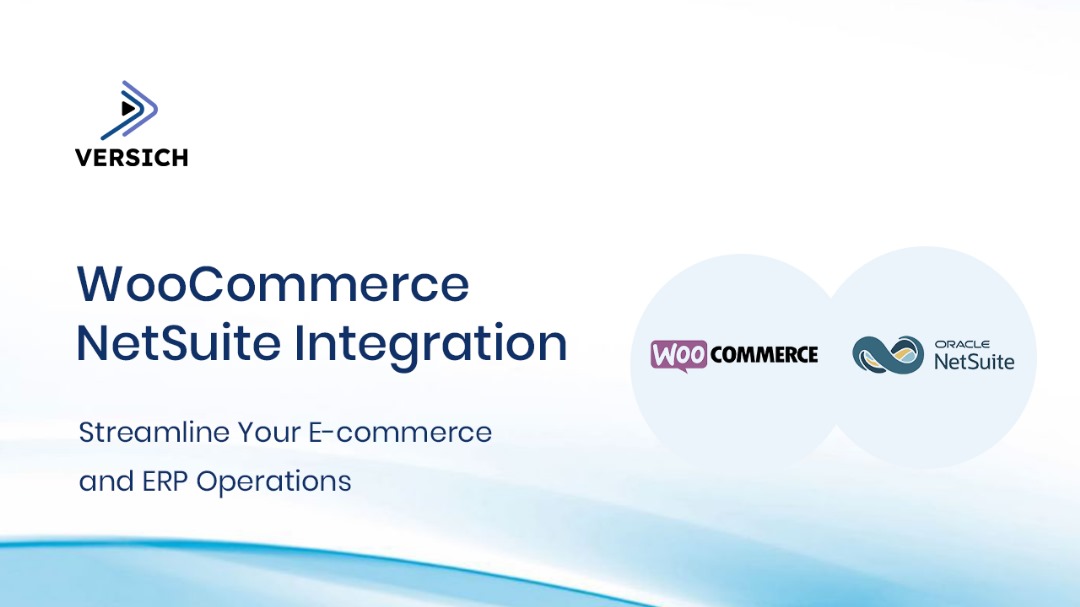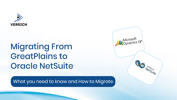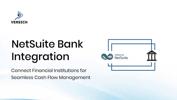In the modern commerce stack, WooCommerce NetSuite Integration is the backbone of unified operations for growing retailers. It connects your WooCommerce store with NetSuite ERP to automate orders, inventory, pricing, and fulfillment, removing the need for manual data entry. By bridging ecommerce and finance, enterprises gain faster order-to-cash cycles, fewer errors, and real-time visibility into stock and revenue across every sales channel.
WooCommerce NetSuite Integration is a bi-directional data sync that automates order-to-cash, product, pricing, inventory, fulfillment, refunds, and customer data between WooCommerce and NetSuite ERP.
What is WooCommerce NetSuite Integration?
WooCommerce NetSuite integration enables a two-way data flow between your WordPress-based store and Oracle NetSuite ERP. Once configured, it keeps your e-commerce front end and back-office financials continuously in sync.
Key functions include:
Orders: WooCommerce orders automatically post to NetSuite as Sales Orders or Cash Sales, depending on payment status. Optional invoice creation and shipping-as-line-item mapping ensure accurate accounting.
Customers: Customer records sync from WooCommerce to NetSuite, either as individuals or companies, maintaining centralized profiles and preventing duplicates.
Inventory & Pricing: Real-time inventory and price levels push from NetSuite to WooCommerce to prevent overselling and maintain pricing consistency.
Fulfillment & Tracking: NetSuite fulfillment events update WooCommerce order status, complete with courier and tracking information.
Refunds & Cancellations: Two-way sync ensures that returns, cancellations, and coupon adjustments reflect correctly in both systems.
Together, these flows eliminate redundant entry, provide financial accuracy, and align your online storefront with ERP-governed processes.
Core Benefits of WooCommerce and NetSuite Integration
Implementing NetSuite WooCommerce integration delivers measurable operational and financial advantages for enterprises and multi-store retailers.
1. Fewer Errors and Manual Tasks
Every transaction, order, refund, or inventory change updates automatically. Teams no longer reconcile spreadsheets or chase discrepancies, cutting error rates drastically.
2. Faster Processing and Fulfillment
Orders flow instantly from WooCommerce to NetSuite for approval and fulfillment, shrinking order-to-cash cycles and improving dispatch SLAs.
3. Consistent Stock and Pricing
Real-time stock and price updates ensure customers always see correct availability and rates, reducing cart abandonment and oversell issues.
4. Accurate Fulfillment and Tracking
When NetSuite marks items shipped, WooCommerce automatically updates order status and emails customers tracking details — a key CX differentiator.
5. Smoother Financial Reconciliation
Payments, deposits, and refunds are synchronized directly with NetSuite GL accounts. Finance teams can close books faster and trust their ecommerce numbers.
6. Scalable Architecture
As sales volume or product catalogs expand, the integration scales seamlessly through queue-based or API-based connectors without performance loss.
Core benefits of WooCommerce NetSuite Integration include fewer errors, faster processing, consistent stock and pricing, accurate fulfillment, and smoother financial reconciliation.
Core Data Flows in WooCommerce NetSuite Integration
The foundation of any successful WooCommerce NetSuite Integration lies in setting up reliable, bidirectional data flows. These flows ensure real-time synchronization between e-commerce and ERP systems so that operations, finance, and fulfillment teams always work with consistent data.
Orders
WooCommerce orders are imported into NetSuite as Sales Orders or Cash Sales, configurable by order status. Enterprises can also enable auto-invoice creation and map shipping as a line item, ensuring freight charges post correctly to GL. The integration supports multi-store, POS, and marketplace orders, allowing unified reconciliation across all channels.
Best practice: Always define clear mapping rules for taxes, coupons, and discounts. Orders with promotions should link to NetSuite discount items or promo forms for accurate margin tracking.
Customers
Customers flow automatically from WooCommerce to NetSuite, either as individuals or companies.
Auto-generated entity IDs prevent conflicts.
You can filter by user roles (e.g., B2B vs. DTC).
Consolidation logic prevents duplicates by matching on email or domain.
For enterprise stores, customer records can carry subsidiary, class, department, and sales rep data, helping segment reports and manage region-specific pricing.
Inventory and Pricing
Inventory and pricing data flow from NetSuite → WooCommerce to maintain consistent on-hand quantities and pricing levels.
Select preferred warehouse or location for stock updates.
Choose the price level (e.g., base, wholesale, regional).
Match SKUs to NetSuite items by Item Name/Number, UPC, or Vendor Code.
With accurate inventory reflected in WooCommerce, oversells drop sharply — a common KPI improvement seen after enabling woocommerce erp integration.
Fulfillment and Tracking
Fulfillment updates flow from NetSuite → WooCommerce. Once items are marked shipped in NetSuite:
WooCommerce order status changes automatically to “Completed.”
Customers receive tracking numbers, carrier names, and pickup dates.
Optional email triggers deliver branded shipping notifications.
Enterprises that rely on 3PLs or multiple warehouses can push partial or split fulfillments seamlessly without breaking customer visibility.
Refunds and Cancellations
Refunds synchronize in both directions — from WooCommerce back to NetSuite and vice versa. This keeps revenue recognition and inventory adjustments accurate.
Coupon or discount reversals map back to NetSuite promotion items.
Refunds trigger restock or write-off logic depending on your return policy.
Optional deletion/restoration syncs help maintain order history integrity.
Optional Data Flows
Beyond the essentials, enterprises can enable:
Product exports (NetSuite → WooCommerce) for unified product management.
Order status updates back to WooCommerce for post-fulfillment sync.
Billing exports for reconciliation automation.
Multi-store management, centralizing data across regional sites.
Must-have WooCommerce NetSuite data flows include orders, customers, inventory, fulfillment, refunds, and payouts, while optional flows add product export, billing sync, and multi-store support.
Options Landscape: Tools and Delivery Models
Different organizations adopt WooCommerce–NetSuite integration through three main delivery models, each suited to specific complexity levels, budgets, and IT capabilities.
1. WordPress Plugin Route
This is the most direct approach for small to mid-sized enterprises using WooCommerce integrations.
Key capabilities:
Real-time order and customer sync between WooCommerce and NetSuite.
Inventory and price imports from NetSuite.
Bi-directional refunds and fulfillment tracking emails.
Cron-based scheduling and detailed API logs.
Support for custom NetSuite fields and conditional mappings.
Advantages:
Quick installation within the WordPress admin.
Minimal coding, ideal for teams without middleware expertise.
Affordable and lightweight for single-store setups.
Limitations:
Limited scalability for multi-store or enterprise reporting.
Less governance and error handling compared to iPaaS or SuiteApp connectors.
2. SuiteApp/Connector Route
This route uses prebuilt SuiteApps listed in the NetSuite marketplace. It’s ideal for enterprises that prioritize NetSuite-native governance and scalability.
Features:
Certified connectors for WooCommerce↔NetSuite with enterprise-grade data flows.
Managed entirely inside NetSuite, ensuring compliance with NetSuite’s release cycles.
Built-in dashboards for transaction monitoring and audit trails.
Advantages:
Deep integration with NetSuite scripting and permissions.
Enterprise-ready SLAs and update cadence.
Native support for subsidiaries, multi-currency, and tax compliance.
Limitations:
Higher setup effort and licensing cost.
Customization often requires SuiteScript or developer support.
3. iPaaS Template Route
For companies already using enterprise integration platforms, iPaaS templates provide the most flexibility.
Platforms like Celigo, Boomi, and Jitterbit offer pre-built templates for orders, customers, inventory, and cash refunds.
Benefits:
Centralized orchestration for multiple systems (ERP, CRM, WMS, 3PL).
Monitoring, alerting, and SLA dashboards.
Extensible for custom logic or new data flows.
Drawbacks:
Requires iPaaS licenses and integration expertise.
Slightly higher latency compared to native connectors.
4. Custom-Built Integration
Enterprises with unique workflows sometimes develop custom middleware. While this allows total control, it’s costly and time-consuming.
When to consider:
Highly customized order types or fulfillment rules.
Proprietary pricing or promotions logic.
Need for bespoke data governance workflows.
WooCommerce NetSuite Integration can be implemented via WordPress plugins, SuiteApp connectors, iPaaS templates, or custom builds each balancing speed, scalability, and governance differently.
Setup and Configuration (Step-by-Step)
Implementing WooCommerce NetSuite Integration requires a structured setup process to ensure authentication, mappings, and sync flows run smoothly. Below is a comprehensive configuration guide for both plugin and connector approaches.
1. Prepare NetSuite Credentials
Before connecting systems, gather all credentials required for secure communication between WooCommerce and NetSuite.
Key elements:
Host URL & Account ID: Found in your NetSuite company information.
Consumer Key & Secret: Created under Integration Records within NetSuite.
Token ID & Secret: Generated for the integration role user.
Authentication Mode: Enable Token-Based Authentication (TBA) and confirm SuiteTalk (Web Services) is active.
Endpoints: Verify Company URLs and ensure the correct SuiteTalk REST or SOAP endpoint is selected.
To connect WooCommerce with NetSuite, enable Token-Based Authentication, generate Account ID, Consumer Key/Secret, and Token ID/Secret, and verify SuiteTalk endpoints.
2. WooCommerce Plugin Configuration
The WooCommerce NetSuite connector plugin simplifies initial setup, offering granular control of sync behavior.
a. General Connection
Go to WooCommerce → Settings → Integrations → NetSuite.
Enter the Account ID, Host URL, keys, and tokens.
Select HMAC-SHA256 for signature encryption and click Save.
Test the connection to validate authorization.
b. Order Sync
Choose which order statuses to sync (e.g., Processing, Completed).
Select how orders sync: Sales Order or Cash Sale.
Optional:
Create customer deposits on payment.
Enable auto-invoice creation.
Map coupons to NetSuite promotions.
Add shipping-as-line-item with internal shipping item ID.
Choose item location, price level, and tax code.
Toggle bi-directional refunds for full or partial returns.
c. Inventory & Pricing
Choose locations and price levels to export from NetSuite.
Define SKU mapping by Item Name/Number, UPC, or Vendor Code.
Enable cron jobs to control sync frequency (e.g., every 15 min).
d. Fulfillment
Turn on fulfillment sync to update order status automatically.
Enable tracking display on customer My Account pages.
Turn on tracking emails with carrier, pickup date, and tracking number.
3. SuiteApp Connector Basics
If using the SuiteApp connector (from the NetSuite marketplace):
Install the SuiteApp package from the catalog.
Authorize WooCommerce credentials within the connector interface.
Map objects: customers, items, orders, fulfillments, and refunds.
Enable each flow one at a time and review transaction logs.
4. iPaaS Template Basics
For enterprises using integration platforms like Celigo or Boomi:
Install the prebuilt WooCommerce–NetSuite template.
Authenticate both endpoints using REST or OAuth credentials.
Map key entities: products → items, orders → sales orders, customers → customer records, cash refunds → refunds.
Enable monitoring and alerting for error tracking and retries.
To configure WooCommerce NetSuite Integration, connect APIs via TBA, map entities (orders, customers, inventory, refunds), and activate flows in plugin, SuiteApp, or iPaaS.
Data Model and Mapping Essentials
Data mapping defines how information travels between WooCommerce and NetSuite. A precise model avoids mismatched items, tax errors, or duplicate customers.
Items and Variants
Woo Product Variants → NetSuite Items: Map SKUs one-to-one. For matrix items, ensure variant attributes (size, color, material) align with NetSuite’s parent-child hierarchy.
Kits and Bundles: Determine whether bundles explode into component items for fulfillment or post as single lines for revenue recognition.
Pricing Levels: Align WooCommerce price tiers (retail, wholesale, dealer) with NetSuite price levels.
Tax Codes: Assign NetSuite tax codes matching WooCommerce’s tax classes; misalignment can cause incorrect GL postings.
Warehouse Assignment: Define the location per line item for multi-warehouse setups.
Pro tip: For WooCommerce ERP integration, always validate item internal IDs and inactive SKUs before enabling inventory export.
Customers
Company vs. Individual Logic: Map WooCommerce “company name” fields to NetSuite Customer Type = Company; map individuals directly as Person.
Duplicate Prevention: Use email or domain match rules; if duplicate detection fails, flag records in NetSuite for manual merge.
Subsidiaries & Classifications: Include subsidiaries, departments, and classes to reflect accurate financial segmentation.
Sales Reps: Auto-assign reps using region or source mapping if applicable.
Orders
Payment Methods & Fees: Map WooCommerce payment gateways (Stripe, PayPal, COD) to NetSuite tenders.
Shipping Costs: Send as a line item using the internal shipping item ID for transparent freight accounting.
Discounts and Coupons: Link to NetSuite promotion records or coupon items; maintain consistency between front-end discounts and back-office ledgers.
Taxes: Standardize tax code mapping to ensure proper jurisdictional accounting across geographies (especially important for UK VAT and UAE VAT).
For accurate WooCommerce NetSuite Integration, map product variants to items, company/individual customers correctly, and align taxes, pricing, and shipping to NetSuite accounts.
Error Handling, Monitoring, and SLAs
At enterprise scale, even the most well-designed WooCommerce NetSuite Integration can fail without proactive observability and recovery patterns. Errors might stem from API throttling, malformed payloads, or mapping inconsistencies. The goal is not to eliminate every fault but to detect, isolate, and resolve issues before they impact customers or finance.
Observability: Dashboards and Logs
Central Monitoring – Whether you use a plugin, SuiteApp, or iPaaS, enable unified dashboards displaying job runs, latency, success rates, and queue lengths.
Detailed Error Queues – Each failed record (e.g., Order #4567) should carry error context, such as SKU mismatch or invalid tax code. Business teams can self-correct without engineering help.
Alerting & Notifications – Integrate with Slack, Teams, or email to push alerts when SLAs breach, for example, “Order Sync Delay > 15 min.”
Latency Tracking – Measure time from WooCommerce order placement to NetSuite order creation. Enterprises typically target sub-5-minute latency for order syncs.
Recovery Patterns
Automatic Retries – Configure retries with exponential back-off for transient API or network errors.
Idempotency Keys – Guarantee that retried messages don’t duplicate orders or refunds; use external IDs or transaction hashes as unique identifiers.
Dead-Letter Queues (DLQs) – Persist failed transactions for manual inspection once retries are exhausted.
Selective Replays – Admins should be able to re-sync single records without rerunning entire batches.
Back-Pressure Handling – During peak events, throttle batch sizes or pause non-critical flows (inventory exports) to keep order sync SLAs intact.
SLA Metrics to Track
Category | Target SLA | Monitoring Method |
Order Import Latency | ≤ 5 min | Job latency dashboards |
Error Rate per 1,000 Transactions | < 2 | Exception counters |
Retry Success Rate | ≥ 98 % | Integration logs |
Refund Sync Accuracy | 100 % | Finance reconciliation reports |
Maintain dashboards, error queues, retries, idempotency keys, and SLAs for latency and accuracy to ensure WooCommerce NetSuite Integration reliability at scale.
Security and Governance
Since WooCommerce and NetSuite exchange customer, financial, and tax data, security and governance must be embedded into the integration design not added later.
Principle of Least Privilege
Create a dedicated NetSuite integration role with permissions limited to necessary record types (Sales Order, Item, Customer, Refund).
Use separate credentials for sandbox and production environments; never reuse tokens.
Restrict WooCommerce plugin or iPaaS users to scoped API keys with read/write only where essential.
Credentials Hygiene
Rotate tokens and API keys every 90 days or in line with corporate policy.
Store secrets in encrypted vaults such as AWS Secrets Manager or Azure Key Vault, not in WordPress configs.
Revoke unused keys immediately after staff or vendor off-boarding.
Implement 2FA/MFA for admin-level accounts managing integrations.
Data Governance
Log every transaction (who, when, what) for auditability and SOX/GDPR/CCPA compliance.
Redact or mask PII in logs and test environments.
Maintain change control version field mappings, and promote updates via sandbox testing before production.
Document data retention and purge policies for completed sync records.
Concurrency and Scalability
Both WooCommerce and NetSuite APIs enforce rate limits (typically 5–15 calls/sec).
Tune concurrency controls in your connector to stay within thresholds.
During flash sales, use batching + queuing to spread API calls while keeping throughput high.
Measure peak load utilization to ensure the system scales linearly with volume.
Secure WooCommerce NetSuite Integration with least-privilege roles, token rotation, encrypted secrets, PII masking, and concurrency tuning for compliance and performance.
Advanced E-commerce Scenarios
As your online retail operation scales, real-world complexity increases. The best WooCommerce NetSuite Integration doesn’t just handle the basics — it adapts to complex business models like multi-warehouse fulfillment, omnichannel returns, and B2B pricing.
Multi-Location Inventory
Modern retailers often maintain multiple warehouses or regional hubs. Your integration should:
Reflect real-time stock per location in WooCommerce using NetSuite’s multi-location inventory feature.
Apply safety stock rules in NetSuite to buffer against over-promising during peak demand.
Handle backorders gracefully — mark items as “available on date” in WooCommerce while keeping NetSuite accurate.
Sync inventory allocation logic so wholesale or subscription orders reserve quantities ahead of DTC demand.
Enable multi-location inventory in WooCommerce NetSuite Integration to display real-time stock, manage safety stock, and prevent oversells across warehouses.
Coupons and Gift Cards
Promotions are core to e-commerce; mapping them precisely prevents reconciliation chaos.
WooCommerce coupons → NetSuite promotions: Each coupon maps to a promotion ID or discount item in NetSuite.
Gift cards: Treat gift cards as line items that debit a liability account in NetSuite until redeemed.
Preserve discount attribution at the line-item level, so NetSuite reports true margins per SKU.
Support stackable coupons by mapping multi-discount logic correctly within SuiteScript or plugin configuration.
Omnichannel Returns
Returns and exchanges initiated from any channel, like online, in-store, or via RMA, must reconcile across systems.
Sync refund initiation both ways: from the WooCommerce customer portal and from NetSuite’s RMA or Credit Memo.
Adjust inventory automatically and update customer order history.
Maintain refund workflow consistency: status changes → payment reversals → inventory restocks → email confirmations.
B2B Accounts
For WooCommerce stores using WooCommerce B2B or Wholesale Suite, integration should extend NetSuite’s ERP logic to company accounts:
Sync company records with corresponding NetSuite Customer (Company) entities.
Map price levels, payment terms, and tax-exempt status for each B2B account.
Support purchase orders (POs) and credit limits natively through NetSuite.
Assign sales reps automatically based on subsidiary or region.
Result: Unified reporting, cleaner invoices, and accurate AR aging for both retail and wholesale lines.
Testing Plan (Pre Go-Live)
Before activating your WooCommerce NetSuite Integration in production, a thorough testing plan is non-negotiable. It ensures accuracy, stability, and compliance — especially when financial data is involved.
1. Functional Tests
Validate that every expected flow behaves correctly:
Orders with coupons, shipping-as-line-item, and mixed-tax configurations.
Partial and split shipments with tracking emails.
Refunds in both directions (Woo → NetSuite and NetSuite → Woo).
Customer filters by role (retail, wholesale).
Multi-location item lines are syncing correctly.
2. Data Integrity Checks
Compare WooCommerce and NetSuite item counts, SKUs, and price levels to ensure parity.
Validate inventory levels per warehouse.
Confirm tax codes, shipping accounts, and discount mappings post correctly to GL.
Monitor for duplicate customer creation.
Check GL postings for correct debit/credit impact on sales, discounts, tax, and shipping.
3. Performance & Reliability Tests
Simulate high-volume order imports (e.g., Black Friday load).
Validate retry logic and ensure no duplicate order creation.
Confirm monitoring alerts trigger correctly during failures.
Measure average and peak latency for order imports and fulfillment syncs.
4. User Acceptance & Cutover
Have finance, operations, and IT jointly test end-to-end scenarios.
Maintain a rollback plan: disable syncs and revert to manual processing if critical issues arise.
Freeze configuration changes 48 hours before go-live to maintain stability.
Document known issues, resolution SLAs, and support contact flow for the first week post-launch.
Before go-live, test WooCommerce NetSuite Integration for functional accuracy, data integrity, performance, and rollback readiness to ensure zero-error launch.
KPIs and Value Realization
Once your WooCommerce NetSuite Integration is live, measuring impact is critical to validate ROI and identify improvement areas. The right metrics show how integration enhances operational efficiency, accuracy, and financial performance.
Order-to-Cash Efficiency
Order Import Latency: Average time from WooCommerce order to NetSuite Sales Order creation.
Pick/Pack/Ship SLA: Adherence to fulfillment SLAs post-integration.
Refund Processing Time: End-to-end speed of return and refund reconciliation.
Tracking Email Time-to-Send: Time between shipment creation in NetSuite and customer notification.
Inventory Accuracy
Inventory Delta: Difference between NetSuite and WooCommerce on-hand counts per SKU.
Oversell Incidents: Frequency of orders placed for out-of-stock items.
Stockout Rate Reduction: Percentage decrease after activating sync.
Finance and Reconciliation
Settlement Discrepancy Rate: Mismatch between WooCommerce transactions and NetSuite payouts.
Refund Variance Rate: Cases where refund totals differ between systems.
Period-End Reconciliation Time: Reduction in time to close books.
Data Quality and Governance
Error Rate per 1,000 Transactions: Benchmark for integration stability.
Duplicate Customer Creation Rate: Should trend to near zero.
Manual Interventions per Week: Reflects process automation success.
Key KPIs for WooCommerce NetSuite Integration include order import latency, inventory accuracy, reconciliation speed, and error rate—quantifying true operational value.
Comparison Pointers
When selecting your integration approach, compare options on feature depth, cost, and scalability.
Option | Core Flows | Refund Direction | Fulfillment Tracking | Inventory Locations | Price Levels | Custom Field Mapping | Monitoring/Alerts | Multi-Store Support | Typical Setup Effort |
Woo Plugin | Orders, Customers, Inventory, Refunds | Bi-directional | Yes | Single | Single | Limited | Basic | Medium | Low |
SuiteApp Connector | Orders, Customers, Fulfillments, Refunds | Bi-directional | Yes | Multi | Multi | Full | Strong | Strong | Medium |
iPaaS Template | Orders, Customers, Products, Refunds | Bi-directional | Yes | Multi | Multi | Extensive | Enterprise-grade | Strong | High |
Custom Build | Fully Customizable | Configurable | Custom | Multi | Multi | Full Control | Developer-defined | Unlimited | Very High |
WooCommerce NetSuite integration options vary by scalability: Woo plugin for speed, SuiteApp for governance, iPaaS for orchestration, and custom build for full control.
Conclusion
For enterprises running WooCommerce at scale, WooCommerce NetSuite Integration is the cornerstone of operational harmony. It bridges ecommerce agility with ERP precision — automating order-to-cash, pricing, and inventory management while ensuring compliance and customer satisfaction.
Whether implemented via Woo plugin, SuiteApp, iPaaS, or a custom build, the end goal remains consistent: real-time, error-free data flow between your storefront and your ERP. The payoff is substantial, faster processing, consistent stock, smoother reconciliation, and informed decision-making backed by accurate data.
At Versich, we specialize in helping enterprises architect, deploy, and optimize their NetSuite integrations for scalability, security, and ROI.
Next Step:
Book a consultation or demo today to see how Versich can transform your WooCommerce–NetSuite workflow into a frictionless, fully automated growth engine.
Download
Woo ↔ NetSuite Mapping Checklist — covers orders, customers, items, pricing, taxes, promotions, and refunds.
Book a Demo
See order-to-cash with fulfillment tracking live — experience automated syncs in action.
Explore the Guide
Peak Season Readiness for Woo–NetSuite Integrations — learn how to manage volume spikes and maintain accuracy.





